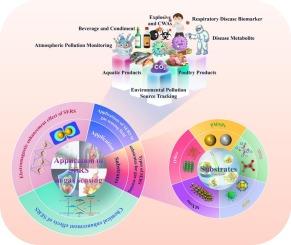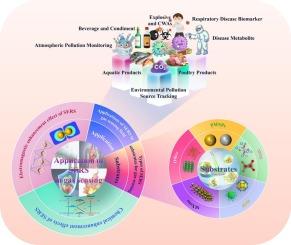表面增强拉曼散射在气体传感中的应用进展
IF 20.3
1区 化学
Q1 CHEMISTRY, INORGANIC & NUCLEAR
引用次数: 0
摘要
从生物医学到环境监测、食品安全和国防,气体检测技术在人类社会中扮演着越来越重要的角色。与固态和液态样品相比,低浓度的气体分子很难识别,这一直是一个挑战。表面增强拉曼散射(SERS)凭借其良好的选择性、高灵敏度和增强基底的优越富集性能,在痕量分析中得到了广泛应用,在气体检测中也具有显著优势。然而,很少有研究对这一迷人的 SERS 方法在气体传感领域的应用进行评论。值得注意的是,有些综述似乎大同小异,都集中在一个特定的主题上,要么是环境监测,要么与人类健康有关。因此,本文首先系统地综述了 SERS 在气体传感领域的最新进展和未来挑战。全面总结了 SERS 的基本原理及其在气体传感中的应用。随后,系统综述了应用于气体传感的 SERS 基底,包括等离子体金属纳米颗粒(PMNPs)、金属氧化物半导体(MOS)、金属有机框架(MOF)、MXene 等。此外,还强调了 SERS 方法在有毒有害气体和气态生物标记物检测方面的应用,如环境监测、人类健康和疾病诊断、食品安全和国防安全等。最后,本文还讨论了 SERS 方法面临的挑战和前景,这将为 SERS 传感器在气体传感领域的设计、构建和应用提供创新思路。本文章由计算机程序翻译,如有差异,请以英文原文为准。


Advances of surface-enhanced Raman scattering in gas sensing
Gas detection technology has assumed an increasingly pivotal role within human society, spanning domains from biomedicine to environmental monitoring, food safety, and national defense. Compared with solid and liquid samples, gas molecules at lower concentrations can be difficult recognized and have always been a challenge. Surface-enhanced Raman scattering (SERS) has gained widespread adoption for trace analysis by virtue of their good selectivity, high sensitivity and superior enrichment performance of enhanced substrates, which also has significant advantages in gas detection. However, few works have focused on the critical reviews of this fascinating SERS method applied in the field of gas sensing. It is worth noting that some of the reviews seem to be similar in that they all focus on a specific topic, either on environmental monitoring or related to human health. Thus, in this work, recent advances and future challenges of SERS in gas sensing are firstly and systematically reviewed. The basic principles of SERS and its application in gas sensing were comprehensively summarized. Subsequently, SERS substrates applied in gas sensing, including plasmonic metal nanoparticles (PMNPs), metal oxide semiconductor (MOS), metal-organic framework (MOF), MXene, etc. were systematically reviewed. In addition, the applications of SERS method used in the detection of toxic, hazardous gases and gaseous biomarkers were emphasized, such as environmental monitoring, human health and disease diagnosis, food safety, and national defense security. Finally, this paper also discussed the challenges and perspectives of SERS method, which will provide innovative ideas for design, construction and application of SERS sensors in the gas sensing.
求助全文
通过发布文献求助,成功后即可免费获取论文全文。
去求助
来源期刊

Coordination Chemistry Reviews
化学-无机化学与核化学
CiteScore
34.30
自引率
5.30%
发文量
457
审稿时长
54 days
期刊介绍:
Coordination Chemistry Reviews offers rapid publication of review articles on current and significant topics in coordination chemistry, encompassing organometallic, supramolecular, theoretical, and bioinorganic chemistry. It also covers catalysis, materials chemistry, and metal-organic frameworks from a coordination chemistry perspective. Reviews summarize recent developments or discuss specific techniques, welcoming contributions from both established and emerging researchers.
The journal releases special issues on timely subjects, including those featuring contributions from specific regions or conferences. Occasional full-length book articles are also featured. Additionally, special volumes cover annual reviews of main group chemistry, transition metal group chemistry, and organometallic chemistry. These comprehensive reviews are vital resources for those engaged in coordination chemistry, further establishing Coordination Chemistry Reviews as a hub for insightful surveys in inorganic and physical inorganic chemistry.
 求助内容:
求助内容: 应助结果提醒方式:
应助结果提醒方式:


